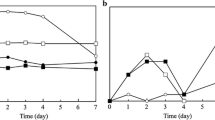Abstract
The aim of the study was to investigate the influence of microencapsulation by spray drying on fish oil sensory quality. Evaluated fish oil powders were coated with modified cellulose, skim milk powder and a mixture of fish gelatin and cornstarch. Samples were stored in the presence of air and under vacuum and then sensory evaluated. It was shown that fish oil powders were very susceptible to oxidation resulting in off-flavor formation. Odor profiles of samples stored in the presence of air were unstable and showed increases in undesirable odor attributes, which were significantly correlated with peroxide value, especially in the case of samples formed by spray drying. Elimination of air from the packaging improved stability of all samples during storage in both odor profile and peroxide value. The main conclusion of this study is that microencapsulation, especially by spray drying, provokes strong changes in fish oil sensory quality. Microencapsulated fish oil powder is not stable and rapidly oxidizes in the presence of air. However, its stability may be improved when stored under vacuum.




Similar content being viewed by others
References
Connor WE (2000) Importance of n-3 fatty acids in health and disease. Am J Clin Nutr 71(S):171–175
Simopoulos AP, Leaf A, Salem N (1999) Essentiality of and recommended dietary intakes for omega-6 and omega-3 fatty acids. Ann Nutr Metab 43:127–131
Thautwein EA (2001) N−3 fatty acids—physiological and technical aspects for their use in food. Eur J Lipid Sci Technol 103:45–55
Sanders TAB (2000) Polyunsaturated fatty acids in the food chain in Europe. Am J Clin Nutr 71(S):176–181
Kolanowski W, Laufenberg G (2006) Enrichment of food products with polyunsaturated fatty acids by fish oil addition. Eur Food Res Technol 222:472–477
Jacobsen C (1999) Sensory impact of lipid oxidation in complex food systems. Fett-Lipid 101(S):484–492
Neil ME, Younger KM (1998) Microencapsulation of marine oils with a view to food fortification. In: Sadler MJ, Saltmarsh M (eds) Functional foods: the consumer, the product and the evidence. Springer, Berlin Heidelberg New York, pp 149–158
Meilgaard MC, Civille GV, Carr BT 1999 Sensory evaluation techniques, 3rd edn. CRC Press, New York
Murray JM, Delahunty CM, Baxter IA (2001) Descriptive sensory analysis: present and future. Food Res Int 34:461–471
Keogh MK, O’Kenedy BT, Kelly J, Auty MA, Kelly PM, Fureby A, Haahr AM (2001) Stability to oxidation of spray-dried fish oil powder microencapsulated using milk ingredients. J Food Sci 66:217–224
Hogan SA, O’Riordan ED, O’Sullivan M (2003) Microencapsulation and oxidation stability of spray-dried fish oil emulsions. J Microencapsul 20:675–688
Heinzelmann K, Franke K, Valesco J, Marquez-Ruiz G (2000) Protection of fish oil from oxidation by microencapsulation using freeze-drying techniques. Eur Food Res Technol 211:234–239
Kolanowski W, Ziolkowski M, Weißbrodt J, Kunz B, Laufenberg G (2006) Microencapsulation of fish oil by spray drying—impact on oxidative stability Part 1. Eur Food Res Technol 222:336–342
Lamprecht A, Schfer U, Legr CM (2001) Influences of process parameters on preparation microparticles used as a carrier system for Ω-3 unsaturated fatty acids ethyl esters used in supplementary nutrition. J Microencapsul 18:347–357
Wallace JMW, McCabe AJ, Robson PJ, Keogh MK, Murray CA, Kelly PM (2000) Bioavailability of n-3 polyunsaturated fatty acids (PUFA) in foods enriched with microencapsulated fish oil. Ann Nutr Metab 44:157–162
Rietjens IM, Boersma MG, de Haan L, Spenkelink B, Awad HM, Cnubben NHP, van Zanden JJ, van der Woude H, Alink GM, Koeman JH (2002) The prooxidant chemistry of the natural antioxidants vitamin C, vitamin E, carotenoids and flavonoids. Environ Toxicol Pharmacol 11:321–333
Let MB, Jacobsen C, Meyer AS (2003) Effects of fish oil type, lipid antioxidants, presence of rapeseed oil on oxidative flavour stability of fish oil enriched milk. Eur J Lipid Sci Technol 106:170–182
Frankel EN, Satué-Gracia T, Meyer AS, German JB (2002) Oxidative stability of fish and algae oils containing long-chain polyunsaturated fatty acids in bulk and in oil-in-water emulsions. J Agric Food Chem 50:2094–2099
Druaux C, Voilley A (1997) Effect of food composition and microstructure on volatile flavour release. Trends Food Sci Technol 8:364–368
ISO 6658:1988, Sensory analysis, methodology, general guidance
ISO 13299:2003, Sensory analysis, methodology, general guidance for establishing a sensory profile
ISO 8586-2:1994, Sensory analysis. General guidance for the selection, training and monitoring of assessors. Part 2, Experts
ISO 8589:1988, Sensory analysis, general guidance for the design of test rooms
Acknowledgments
This work was supported in part by research grant from German Academic Exchange Service. Authors thank DSM Nutritional Products for free sample of fish oil preparations. Authors also thank Georg Brener GmbH for thefree sample of methylcellulose.
Author information
Authors and Affiliations
Corresponding author
About this article
Cite this article
Kolanowski, W., Jaworska, D., Weißbrodt, J. et al. Sensory Assessment of Microencapsulated Fish Oil Powder. J Amer Oil Chem Soc 84, 37–45 (2007). https://doi.org/10.1007/s11746-006-1000-x
Received:
Accepted:
Published:
Issue Date:
DOI: https://doi.org/10.1007/s11746-006-1000-x




